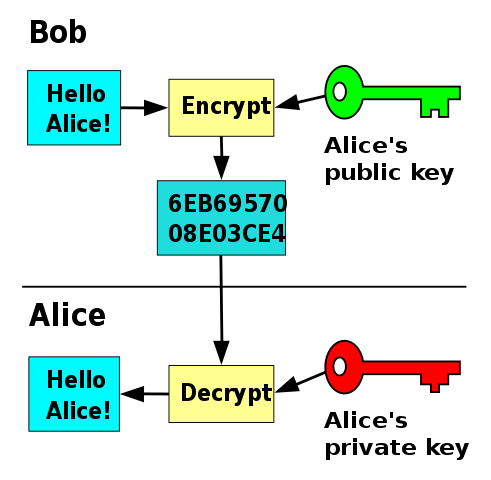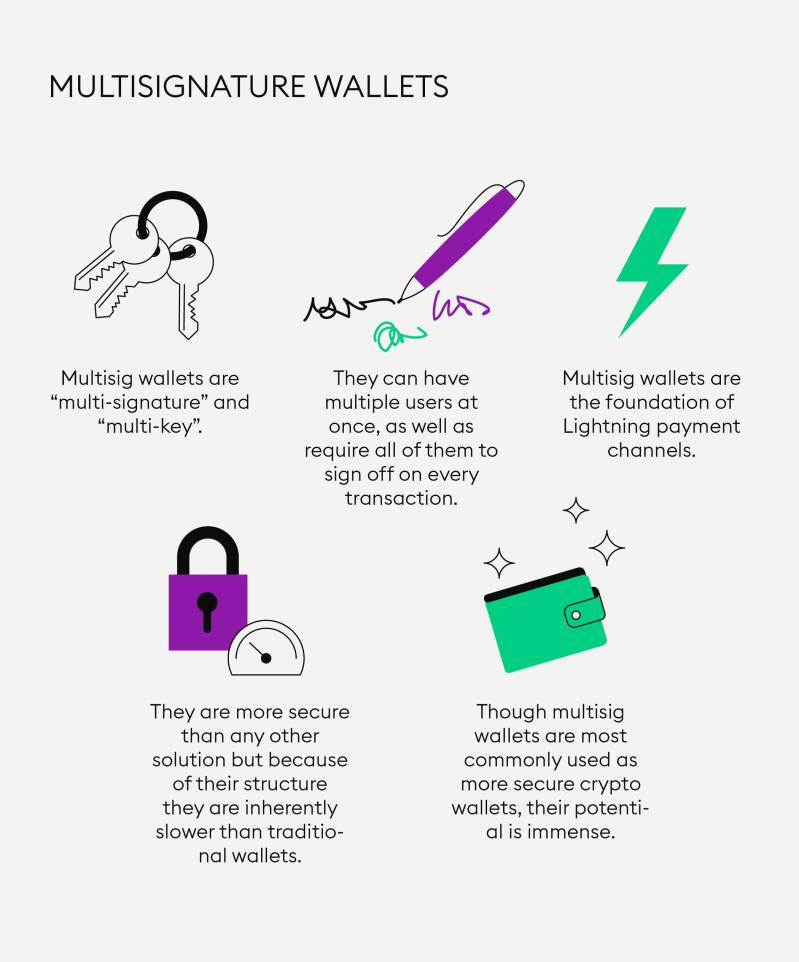
How to keep your crypto as safe as possible? One of the techniques that can make this possible is multisignature. Such multisignature wallets work in a completely different way than normal wallets do.
Private keys and public keys, digital signatures... A brief recap.
Public and private keys
The public and private key is an incredibly important part of the blockchain. It ensures that transactions on the blockchain are carried out securely. The private key is a series of letters and numbers that only you know. You can compare this to a key to your mailbox. Only you can open it and see its contents. Nobody else has that key. The public key, on the other hand, is visible to everyone. This is also a series of letters and numbers. This sequence cannot be directly traced to a specific person. You can compare a public key with a postal address. Everyone can see it and everyone can send something to it. So you can also securely share the public key with others. The private key is something you should not share with others. If you do, you lose your crypto. Because whoever has your private key will also have access to your wallet.
As mentioned, the private key and public key consist of a series of letters and numbers. They also say nothing about the person behind it, number of crypto, etc. The public key and private key are generated for you when you first create a wallet.
The private key and public key are generated by means of the hashing technique. This is a process that converts input into output. This output consists of a series of letters and numbers. Hashing also only works in one direction: from input to output. The output cannot be converted to the input.
The private key and public key are not two separate, independent keys. These keys work together. This cooperation is also called the digital signature.
Click here for more information on the public key and private key.
Digital signature
If you want to make a transaction, for example send crypto to another person, you have to sign the transaction. This signing is done by means of the private key (usually). But this signing can also be done by means of the public key. When you combine this combination between private key and public key, a unique digital signature is created. This signature can only be created when someone is in possession of the correct key combination. Because the private key is strictly personal, a digital signature can only be created by the rightful owner (unless the private key is stolen).
Click here for more information on the digital signature.
Wallet address
If you want to send crypto to someone else, you need a crypto wallet. A wallet has a special address where you can send crypto to. This address is a hash of the public key. This means that the public key has been converted to a new set of numbers and letters. This makes the wallet address directly linked to the person the public key belongs to (new wallet address is actually the public key). When you make a transaction from the wallet, the nodes in the blockchain network check if the digital signature is correct. This way they know for sure that someone is authorized to send certain crypto.
So the public key is used to send transactions, but also to receive them. Only the legitimate owner of this wallet address can receive the transaction with his public and private keys. Without the combination of these keys, the transaction will not be executed.
What is Multisig?
From the word Multisig you can easily deduce what this word consists of. Multisig requires more than one signature (digital signatures) to access a wallet. Multiple signatures are required for both gaining access to crypto, as well as sending it.
In a wallet where there is no Multisig feature, there is only one private key. This is convenient and easy if you want to access a wallet on your own or if you have a lot of money that you want to keep to yourself. You are then the only one who has access to your wallet and you can send crypto using your private key and public key. Therefore, there is only one digital signature.
In a Multisig-wallet there are multiple private keys involved. To make a digital signature (sign a transaction) you need several private keys that sign off. Suppose you have a wallet with 5 private keys. Only if all these 5 private keys sign off, you can create a digital signature. If 3 out of 5 private keys do not sign, you cannot create a digital signature and verify a transaction (e.g. send crypto). You need all the private keys. On the other hand, if you want to get access to the MultiSig wallet, you also need all private keys to be signed.
Click here and here for more info with regard to Multisignaturses.
Different types of multisignature wallets
2-of-2 MultiSig-wallet
This is similar to two-factor authentication. It requires you to enter a password and a code sent to your phone number or email address. You can only access your account if both your password and code are correct: 2 of the 2 must be correct.
With a Multisig wallet, you need 2 private keys to make a transaction or gain access to that wallet.
The advantage of 2-of-2 MultiSig is that it is more secure than single-signature. The disadvantage is that you will lose access to your crypto if you lose one of the private keys.
2-of-3 MultiSig-wallet
A total of 3 private keys are available here. But if you want to access that wallet or if you want to make a transaction, you need 2 of the 3 private keys. Exchanges often use the 2-of-3 Multisignature. They keep one private key online, one offline and one private key with an external security company. Should one of the private keys be hacked or lost, the wallet is still safe.
1-of-2 MultiSig-wallet
The 1-of-2-Multisig-wallet is useful for people who share a wallet together. Suppose you have a business wallet where you and your business partners can access it.
However, it is safer to both be in possession of their own private key. To access the crypto (or send funds) you only need one of the created private keys.
It is also possible to make other combinations regarding Multisignature and private keys. For example, you can create 1-of-3, 1-of-4 but also 1-of-5 MultiSig wallets.
Be careful though, because the more private keys that are in circulation, the greater the risk of a private key being stolen or lost.
Pros and Cons of Multisig-wallets
Pros
-
Your crypto is kept a lot more secure because you need multiple private keys signing off. So a multisig wallet is more secure than a single signature wallet.
-
You're also not dependent on a single device. Do you have all your crypto on a single-signature hardware wallet and do you lose the wallet, then you have lost all your crypto. With a multisignature wallet, you don't have this problem.
-
People who travel a lot have an advantage with a multisig-wallet. If you travel a lot, you have to take your wallet with you each time (online via your online wallet or your hardware wallet). It is then safer to use multi-sig because you ensure that if you lose your wallet or it gets hacked, nobody but you can access your crypto (the hacker has to hack or get hold of multiple private keys; not easy!).
Cons
-
For example, have you forgotten or lost your private key? Restoring a Multi-sig wallet is not easy. This is logical because you have to deal with multiple private keys and multiple recovery phrases. This often takes a long time. But this can be overcome by always saving your recovery phrase properly.
-
Setting up a multi-sig wallet is not easy. Setting up a single signature wallet is easy, though. The wallet automatically creates it for you. Because a multi-sig wallet requires the creation of multiple private keys, it is a technical challenge.





Reactie plaatsen
Reacties